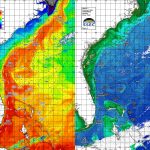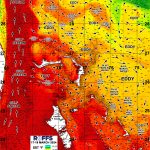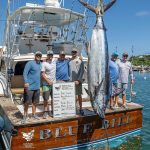
Monitoring of the Hurricane Harvey Plume in the Gulf of Mexico
This project proposes to track, map, and provide a spatial analysis of the freshwater plume runoff in the Northwest Gulf of Mexico resulting from Hurricane Harvey using a combination of ocean color and infrared imagery. The satellite data will be derived from a variety of polar orbiting satellites from NASA, NOAA and the European Space Agency (ESA).
The amount of rain, subsequent flooding and runoff into the ocean from Hurricane Harvey is an environmental concern due to its impacts on the fauna and flora of the coastal ocean. Not only is freshwater input with its turbidity and increased chlorophyll + colorized dissolved organic matter (CDOM) of concern, but the industrial and domestic household chemicals causing pollution in the water are of concern as well (Tabuchi, 2017). Tropical storms have been known to cause significant short-term biological effects by redistributing species or forcing them to migrate and longer-term effects such as smothering oyster beds, reducing the recovery rate of corals, and changing the recruitment success from eggs to juveniles. However, longer-term effects are not well studied and thus, in light of this major, Category 5 storm, there is a critical need for the proposed work. Fisheries managers need to know immediately the spatial and temporal extent of the plume which will assist them to evaluate which stocks are likely to be affected and what management strategies need to be modified in light of this disturbance.
This proposed research is of high significance and likely to have a long-lasting impact due to the increased understanding of such events on the short-term and long-term impacts of tropical events on the fauna and flora in the Northwest Gulf of Mexico, along with the transport and fate of the polluted water offshore. The beneficial impacts to fisheries managers is that the derived environmental data will be used for stock assessments which is mandated by the Magnuson – Stevens Fisheries Management Act in ecosystem based fisheries management. Incorporating the environmental conditions will result in improved stock assessments and fisheries management. This project will map the impact of such major tropical storms on the distribution and concentration of terrestrial and ocean carbon fluxes by tracking the ocean color – chlorophyll signal in the Northwest Gulf of Mexico, which is critical in understanding the carbon cycle through the ocean ecosystem and back to the atmosphere.
Weekly summaries and maps will be provided on the ROFFS™ website and publicized widely through social media, press releases, ROFFS™ Fishy Times Newsletter, and direct email to a variety of agencies and fisheries managers. The distribution will focus primarily on scientists, fisheries – managers and fishers, and also the general public. The data will be available to interested persons via ROFFS™ website.

Please click HERE to read the FULL proposal and view updated data on our website now!
Gulf of Mexico Early Season Preview 2018 – PROMISING FISHING CONDITIONS IN GULF OF MEXICO
As in previous years, ROFFS™ is providing an early spring analysis of the oceanographic conditions for the Gulf of Mexico region using a combination of satellite data including sea surface temperature (SST) and ocean color/chlorophyll images from mid-to-late March 2018. We will discuss the overall ocean conditions for the current spring fishing season and how they may transition into the summer conditions compared to the same time last year.
Roffer’s Ocean Fishing Forecasting Service, Inc. – ROFFS™ (roffs.com) has a 30+ year history of monitoring the ocean conditions throughout the Gulf of Mexico for research and fishing applications. Infrared (IR) satellite data is used to observe the SST and ocean color data is used to derive indices of phytoplankton (chlorophyll), water clarity, and colorized dissolved organic material (CDOM). Combined with other oceanographic data and in sequence, these data allows one to visualize the dynamic surface ocean currents. The satellite data is derived from a variety of sources including NASA, NOAA, Suomi National Polar-orbiting Partnership (SNPP), and the European Space Agency (ESA). ROFFS™ also uses a plethora of different data derived from drifting buoys, gliders, aircraft, fishing vessels, and satellite altimeters. The altimeter data provides a relatively coarse spatial (~15 mile) and temporal resolution (5-10 days) that limits the data’s usage for studying large-scale circulation. It is not useful for evaluating smaller scale and short-term (daily and sub-daily) changes in the ocean currents or their water mass boundaries that control the location of forage fish and the larger, more valuable predator fish.
Background and Some Observations for 2018
It is important to look at the year-to-year trends and anomalies to get a better understanding of how the ocean conditions compare regarding the conditions and location of the fishes preferred habitat and the likelihood of a productive fishing year. Comparing the similar locations and features to last year, the SST of the core of the Loop Current for late-March 2017 was 81.5°F, and for this year over the same time period, it was 80.6°F, which is cooler than last year and more in line with previous years since last year was a relatively warmer year. Furthermore, the SST this year in the offshore northwestern Gulf of Mexico area is 71.5°F-73.0°F, which is approximately 1.5°F cooler than last year at this time. The SST in the offshore southwestern Gulf of Mexico area was observed to be within the 76.0°F – 77.0°F range this year, which is similar to last year, but much warmer than in 2016. Also of note is that the coastal SST’s along the west coast of Florida to the western Gulf of Mexico are showing temperatures approximately 3.0°F to 5.0°F cooler than last year, but still were warmer than they were during the same time period (late-March) during 2016. It appears that this years SST’s throughout the Gulf of Mexico are somewhere between the cool 2016 year and warm 2017 year. It remains to be seen if 2016 was a much cooler than normal year or if 2017 was a much warmer than normal year for the late March time period.
These cooler than last year SST readings throughout the Gulf of Mexico are likely related to the higher winds and cooler atmospheric temperatures this spring compared to last year. This suggests a slight delay in the arrival of larger pelagics (tuna, wahoo, dolphin, marlin, kingfish) closer to the coast and traditional fishing grounds compared to last year. We have heard that the stronger than normal spring winds over the past months associated with the multiple fronts have made it difficult for offshore fishing. However, when the weather permits, there have also been some recent reports of scattered sailfish west of Tampa and marlin, wahoo and good yellowfin tuna action south of Louisiana and in the northeastern Gulf of Mexico. These good reports south of Louisiana are likely due to the large dominant Loop Current eddy located south of Louisiana (Figure 1).

Please click HERE to read the FULL early season preview on our website now!
New/Updated Videos on ROFFS™.com – Click the “Hot News” Button on ROFFS™ Homepage
Texas Billfish Classic!

Get ready for the 2018 Texas Billfish Classic – 2017 Texas Billfish Classic Official Video. Video Courtesy: Texas Billfish Classic | Facebook
Please click HERE to watch the video on our website now!
Rainy Runway!

Some pilots and airports should know when to stop operating. I guess in some parts of the world this is acceptable.
Please click HERE to watch the video on our website now!

Capt. Billy Maxwell (Tuna Fever) of Oregon Inlet, NC starts his 2018 season in good tuna form. Keep an eye out for our ROFFS™ early season preview for the Northeastern U.S. coming up in approximately two weeks!
Please click HERE to view recent 2018 tournament winners on our website now!
Whale Shark Rescue!

Watch divers rescue four whale sharks—each the size of a car—trapped in fishing nets. Video Courtesy: National Geographic | Facebook
Please click HERE to watch the video on our website now!
Baby Stingrays!

Baby stingrays just swimming around. Video Courtesy: Simply Beautiful | Facebook
Please click HERE to watch the video on our website now!
Backlash? Feedback?

As always, please send comments & feedback on Fishy Times newsletter content directly to us at feedback@roffs.com.
If you do not want to wait for our next Fishy Times newsletter, please visit us in the meantime to get all your fishing news using the social media/web links below. Safe and successful fishing until next time!





